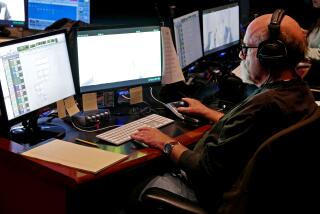Testing, Testing . . . Is There a Market for This?
- Share via
For 60 years, the reproduction of sound has depended on the loudspeaker.
There have been many new means of getting the signal to the speakers--phonographs and radios and compact discs--and there have been many improvements in the mechanism. But in the end, sound always emerges from a device that uses electrical signals to cause a piece of material--usually a conical woofer or tweeter--to vibrate, which in turn excites air molecules in such a way that sound is re-created.
Now an inventor named Elwood Norris may be on the brink of changing all that. He’s developed a completely new type of sound reproduction system, called Hypersonic Sound, that eliminates the need for speakers as we know them.
Norris’ San Diego-based company, American Technology Corp., last month reached an agreement with the high-end audio firm Carver Corp. to commercialize the invention, and he plans a formal roll-out at the consumer electronics show in Las Vegas in January.
At the heart of the Hypersonic Sound system is an acoustical phenomenon known as the Tartini tone. Giuseppe Tartini, an 18th century Italian composer, noticed that when two notes were played steadily and with great intensity, a third, different note could also be heard. This was the result of the two original sound waves crossing, and its frequency was the difference between the two original waves.
Norris found a way to exploit this phenomenon by using very-high-frequency transducers. Transducers, initially invented by Alexander Graham Bell, are devices that receive energy from one system and retransmit it in a different form; Norris’ transducers use electrical energy to vibrate a tiny crystal, changing the energy into sound waves.
The system uses two transducers, one with a fixed frequency and one that can be varied. By crossing the two beams--one operating at, say, 200,000 cycles, 10 times higher than what the human ear can hear, and one varying between 200,000 and 220,000 cycles--an audible tone of about 0 to 20,000 cycles is created. (It can be higher or lower to produce different sounds.)
Norris, whose previous inventions include a cordless microphone and an ultrasonic technique now used in medical imaging, says the system produces sound “extremely superior to that produced by a loudspeaker.”
That’s because it requires less power for the same volume, and only very small changes in power are needed to create different sounds--in contrast to a traditional speaker system, which needs big, distortion-creating power boosts.
“The transducers are only about the size of a pea,” explains Norris, “yet they create the full spectrum of sound. Sound quality no longer depends on the size of your speakers.”
Further, because the “difference tone” emerges from the point where the two beams cross, positioning the transducers in a certain way means the sounds can emerge from any point in space. That creates some interesting possibilities for cinematic sound effects and other applications.
“Norris’ technology offers a potential solution to a number of audio problems,” says Rick Lehtinen, a former broadcast engineer and currently senior analyst at In-Stat, a Scottsdale, Ariz.-based high-tech market research firm. “It should make a much greater level of efficiency possible . . . and it should also greatly diminish or do away with the problem of feedback.”
Norris’ invention is compatible with existing audio equipment and recording and broadcasting techniques.
Commercialization, of course, won’t be an easy task. But Carver, which designs, manufactures and markets conventional loudspeakers, is optimistic.
“We have explored many audio technologies, including HSS-like systems,” says Jim Croft, vice president of research and development for Lynwood, Wash.-based Carver Corp. “But the advancements accomplished by the ATC team to make this technology realizable is a real breakthrough in sound reproduction.”
Mary Purpura and Paolo Pontoniere can be reached via e-mail at PMPurPont@aol.com






